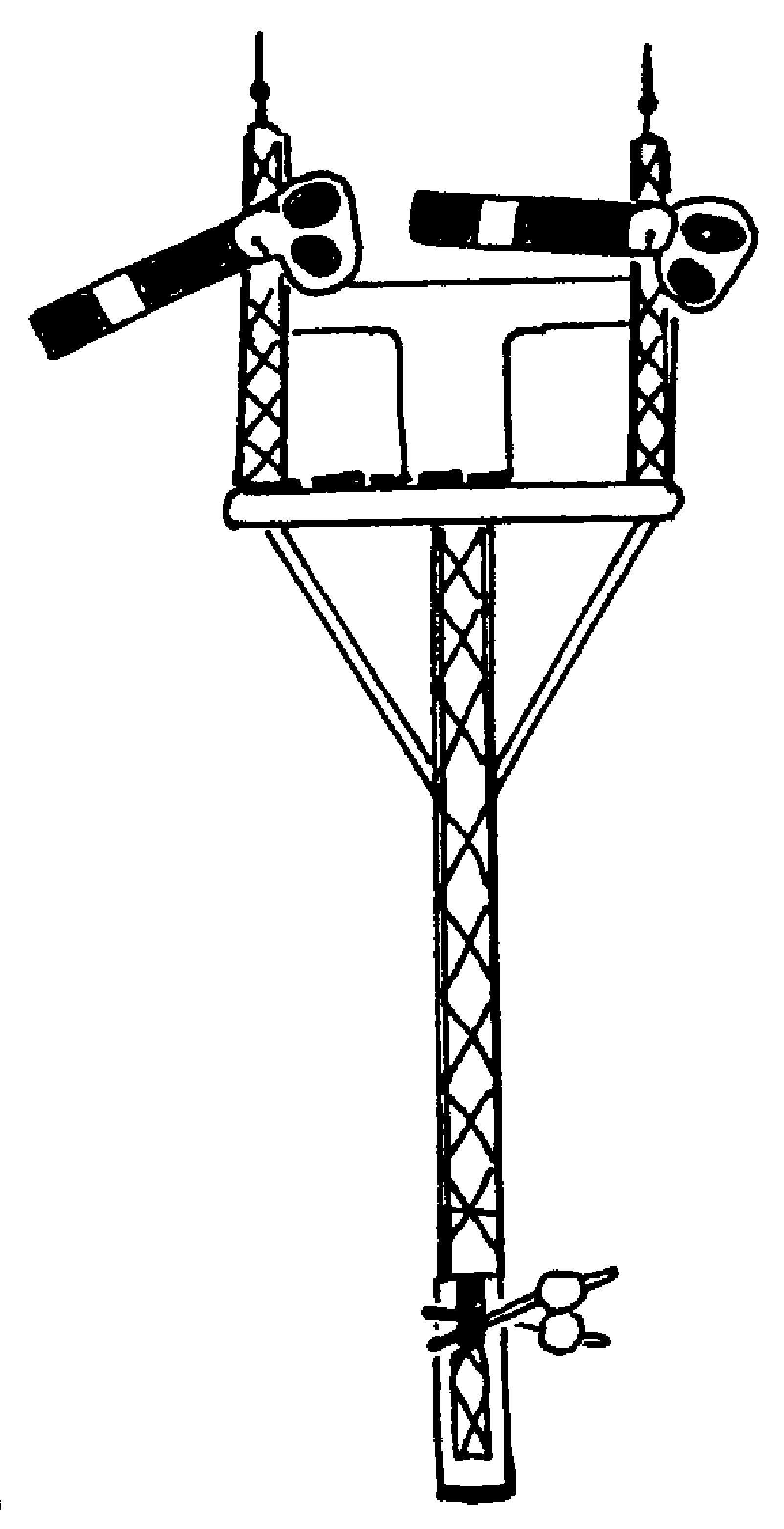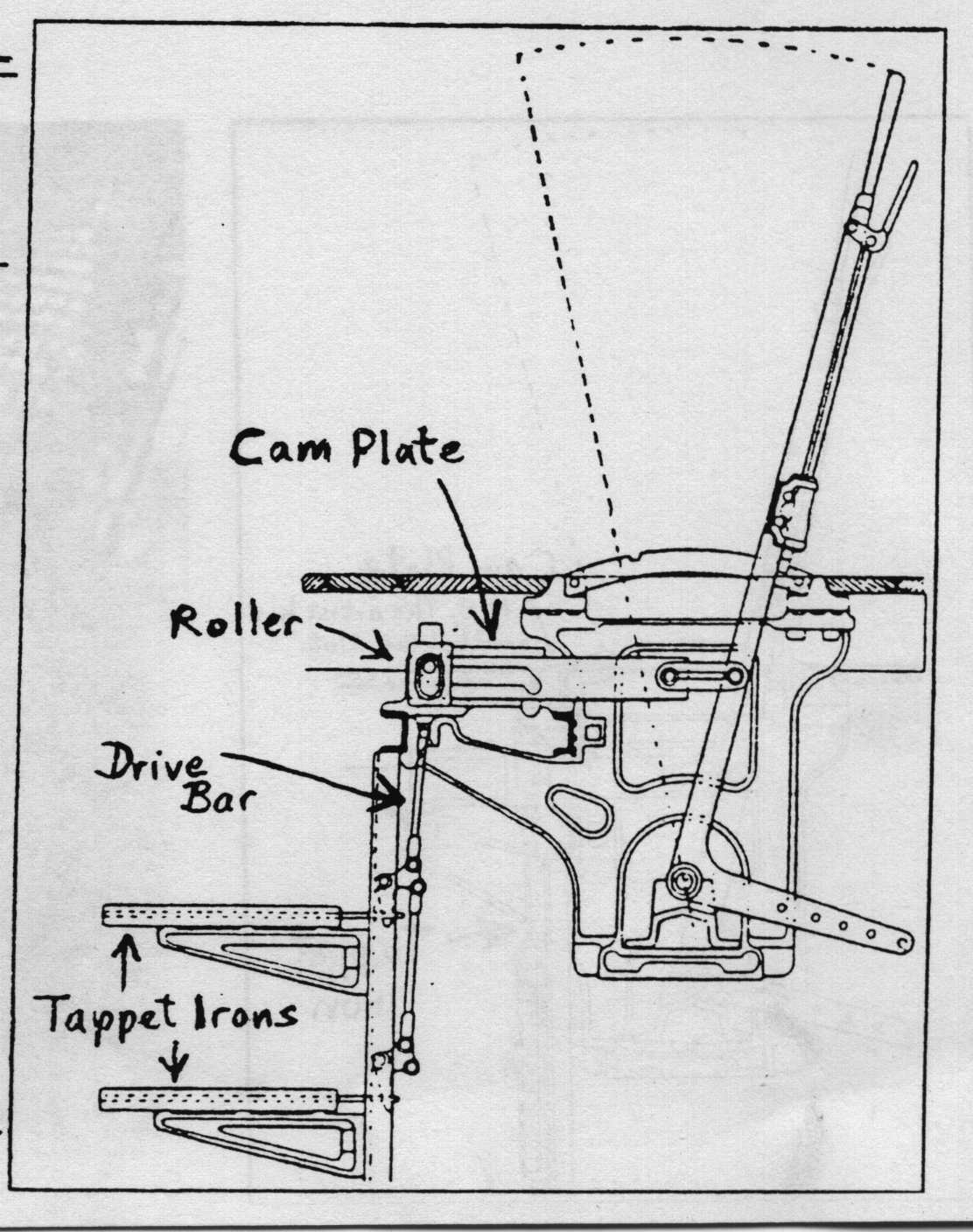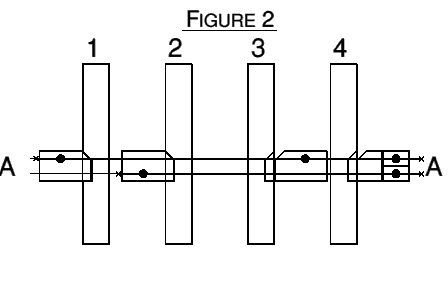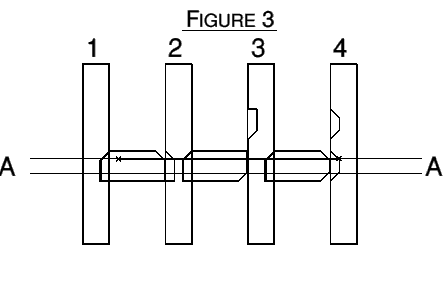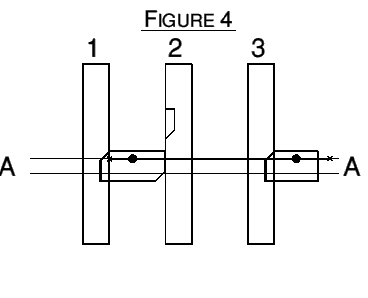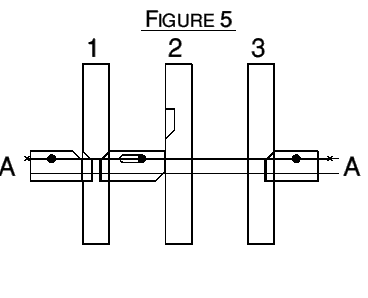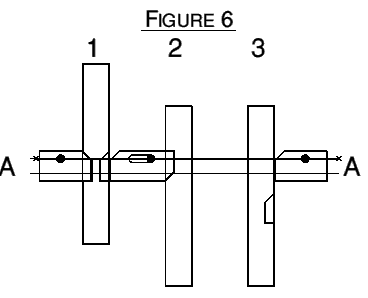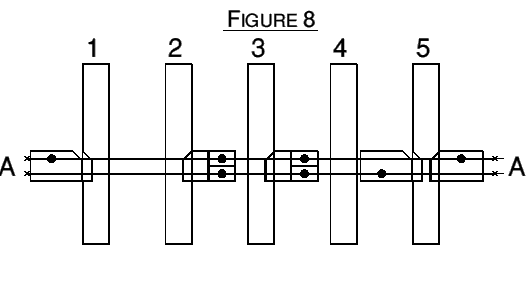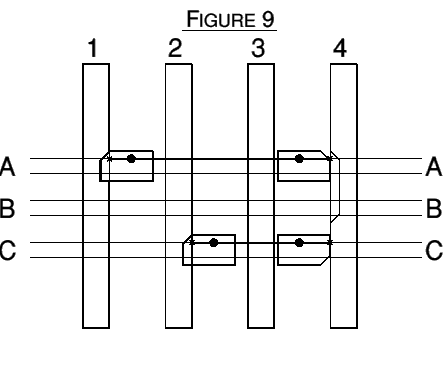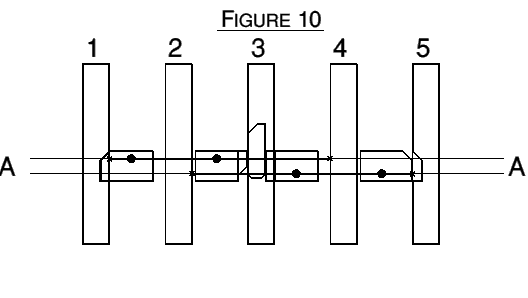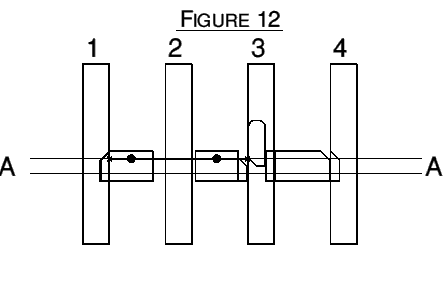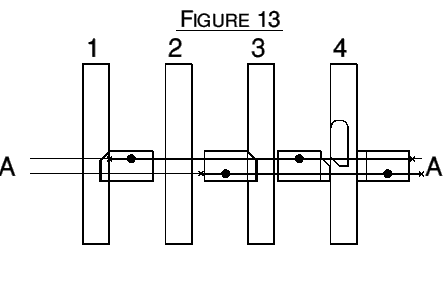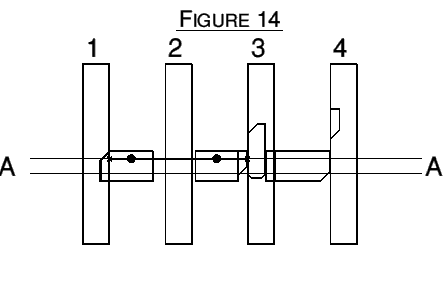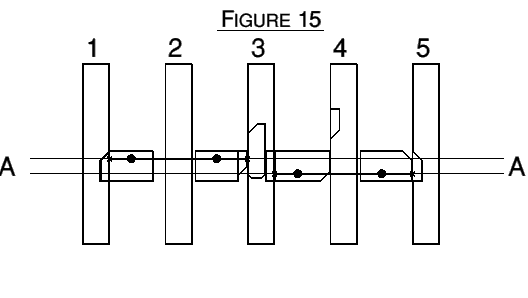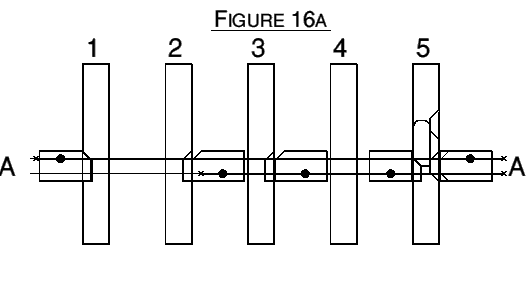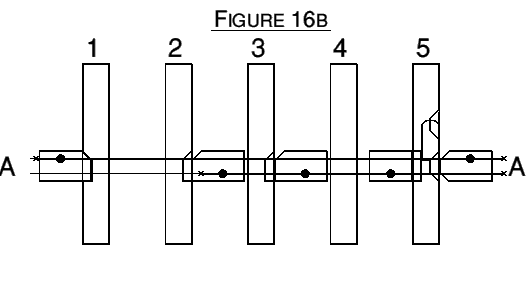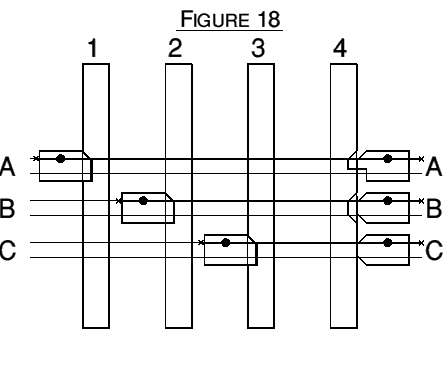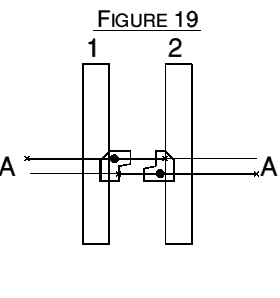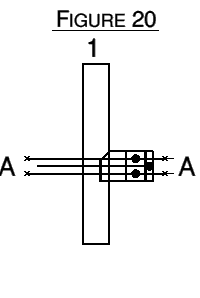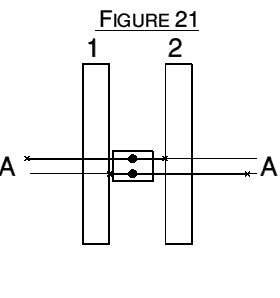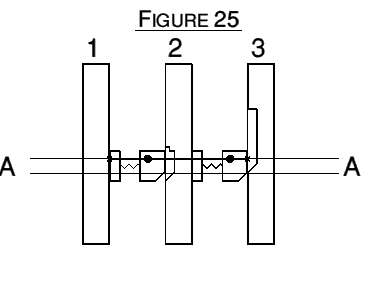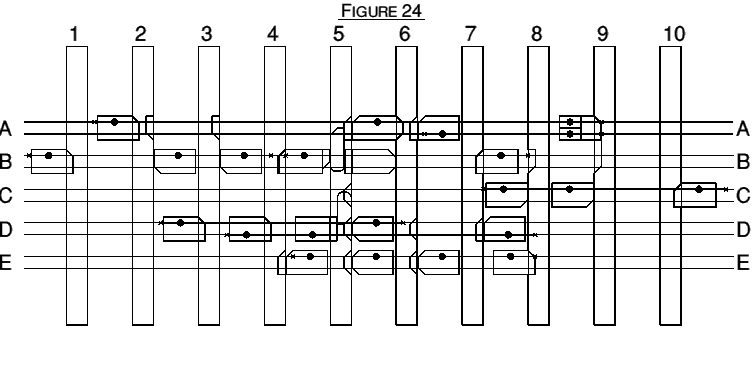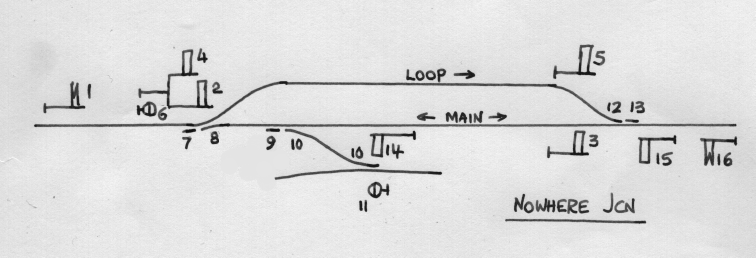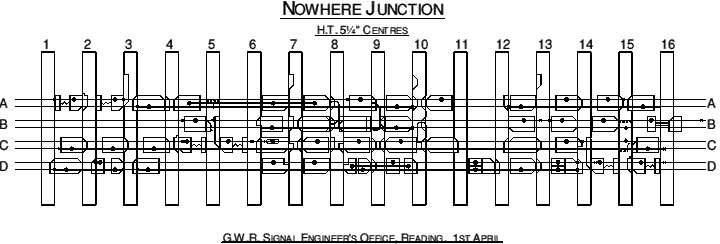Great Western Railway 3-Bar Tappet Lever Frames
1. Development
Considering the shortcomings of both the double twist and stud locking frames, it is surprising that the GWR was so late in introducing tappet locking which had been successfully used by other companies for some time (see SRS Signalling Paper No.1). The first known tappet frame was that for Cardiff West box, 75 levers, ordered from Reading Works on 20th December 1904. In view of the size of this frame it seems likely that there was an earlier "trial run" not recorded or that a mock-up was tried out at Reading Works.
The 3-bar frames comprise three types, summarised as follows:-
- Horizontal tappet, 5¼ inch centres, 1904
- Horizontal tappet, 4 inch centres, 1908
- Vertical tappet, 4 inch centres, 1909
2. Construction
The design of the 5¼" frame closely followed that of the double twist and stud frames. With the exception of the interlocking and its supporting parts, many of the items were the same. Thus the HT 5¼" frames had several of the fixings for twist locking. With the changeover to 4" frames many of the supporting parts had to be altered and an entirely new set of main castings was designed. The design was not substantially altered however. The mechanism is supported on two long horizontal timbers, 11" x 3" or larger which are inset at one end into an extra pier of brickwork added to the battery room wall (in type 7 boxes - for box types see SRS Newsletter Nos. 60 and 62, January and May 1980) and fixed at the other end to a stout timber upright. Extra support is given by 2¼" steel tubular uprights fixed to the floor of the locking room. Thus none of the weight of the frame is borne by the external walls of the box.
The timbers are fixed with their top surface 3 feet below operating floor level. Mounted on these are cast iron stanchions reaching nearly to floor level. The long cast iron members which are bolted on top of these, the lever guides and treads which they support are all the same as on earlier frames. Levers are 76½" long with 12" machined and polished tops, pivoted 30" below the treads and travel through an arc of 31.3° when pulled. One hole was provided in the lever tails for point connections with additional holes for signal wires; six holes are provided in the HT 5¼" frames and four in the 4" frames. Stanchions are fitted approximately every 15 levers and are thin enough to be fitted between two working levers. Most frames built before 1920 have a date on them in the form of a small metal disc bolted on the end stanchion. Some frames have the date of construction stamped on the end of the lever pivot casting.
The locking is driven from the lever by a slotted cam plate which reduces 10¼" of horizontal movement to 1¾" of vertical movement.
The cam is mounted on two rolled steel joists running the length of the frame. Thus far all three frames are basically the same, the 4" frames in fact being identical at operating floor level. On HT frames vertical angle irons are mounted behind each lever. Fixed to these are brackets to support the locking trays which came in standard sizes:-
- HT 5¼" - 6 or 7 levers, 5 channels or 11 channels
- HT 4" - 9 levers, 11 channels
The movement of the tappets is guided by slots in a casting which also has horizontal slots in which bars and locks may slide, one bar behind the tappets (the bottom bar, bar 2) and two bars above (the top bars, bars 1 and 3). These bars are attached to locks which fit snugly into the space available and are thus free to move in only one direction, transverse to the tappet movement. The locking is held in place by straps or cages of straps and covered by plates.
Trays were simply cut up to make the required number of levers, no attempt being made to round up the size of frame to suit them. Screwed down metal lids covered the trays. Ironwork was usually made for two or three trays of locking; where only one or two trays were required provision was usually made for an extra tray. Three trays could be accommodated in standard (8 feet above rail level) height boxes but if four or more trays were needed the box had to be built higher. Down-rods and angle cranks transmitted the drive from the cam into movement of the tappet which travelled 1¾".
The arrangement on VT frames was somewhat similar. The locking was mounted closer to the levers giving considerably more room behind the frame. This is believed to be one of the reasons why boxes built after these frames were introduced were often narrower than previously. Locking trays were all of one size, for 9 levers and housing 10 channels of locking. Again the trays were covered by removable lids. One advantage of these frames was that the cam worked directly onto the top of the tappet, dispensing with the down-rod and crank arrangement of the HT frames. Where two locking trays were installed the tappet was simply extended through the top one to reach the bottom.
The change to frames with 4" centres had the obvious advantage that a larger number of levers could be housed in a given sized box, there being many cases where an older frame was replaced by a 4" one without the need for extending the box itself. Despite this, there was no overnight change from 5¼" frames, the older type being installed for a good many years afterwards, doubtless in some cases using second-hand parts.
One feature of the 3-bar frames is the use of loose treads between levers; these clank distinctively as the signalman walks up and down the frame, more noticeably so in 4" frames! In addition to these standard treads, other types were required at each end of the frame, these being blocked in on one side. As in the past, when new frames were installed, a number of spare levers were installed, usually three each end in small boxes. Many of these were never used and about 1910 the practice was dropped of actually installing the spares, spaces being left instead. On these frames a new type of tread was introduced which completely covered in the frame where a space occurred. This went some way towards reducing the amount of dust going down and draughts coming up. To accommodate these treads the lever guides, which rise nearly to the level of the treads on a working lever, had to be removed. Where a series of spaces ended, a further type of tread was now required, narrow enough to enable a lever guide to be provided on one side only next to a working lever. This of course further increased the already considerable number of parts required.
The first known example of a 4" HT frame was at Cleobury Mortimer where a new box was opened in October 1908. The following year the first VT frames appeared but they were only used for frames of up to 60 levers - naturally there were exceptions. VT frames had the advantage that access to the locking was easier than on HT frames but, against this, only two trays of locking could be accommodated in a standard height box; this is believed to be the reason why HT frames were used for larger installations. Though a large number of new boxes were built in the period up to 1915, and a good many older frames were replaced, not many were over 60 levers so that the VT frame became more or less standard until the introduction of the 5-bar frame in 1923. Stud frames continued to be used for many smaller frames even after this time while a number of 3-bar VT frames were still installed long after the 5-bar had been introduced. Several 3-bar frames were installed in the early 1940's, but these were fitted with 5-bar locking. Though the three types of 3-bar frame varied in appearance and construction, the locking was basically the same on all of them, though the parts varied in detail. It is therefore possible to describe the locking for all three in one section.
3. Dead Locking
Moving the lever from the normal position through about a tenth of its travel moves the tappet downwards (on a HT frame, away from the driving crank) by half its travel distance - this encounters any locking designed to hold the lever normal - further movement of the lever continues with no tappet movement until the last tenth of its travel during which the tappet completes the rest of its travel and releases locking on levers which need that lever reverse. Usually the tappet travels a standard distance of 1¾" which corresponds to the channel separation. On converted frames, a different tappet travel may be accommodated, but this would mean that a normal port cut in one channel may not (in such cases) operate as a reverse port in the channel below as it normally would and reverse ports would be cut in an adjusted position. An example of this is Bewdley South on the Severn Valley railway.
Fig. 1 shows the symbols used on dog charts for these frames.
The locks generally engage with ports cut into the tappets, so that tappet movement drives locks sideways, either engaging another tappet directly or indirectly by the movement of a bar, either in tension or compression, depending on which face of the tappet is engaged. Each tappet is 1 11/16" wide: in a frame with 4" lever centres, the width of a lock sitting between two tappets will be just less than the spacing, i.e. 2 5/16" including the 3/8" bevelled nib on one end (so that it can sit between two tappets without engaging a port). Alternatively a lock may be 2 11/16" wide with a bevelled nib on both ends so that it engages with both adjacent tappets and is called an 'interlocker'. The extra spacing in a 5¼" frame allows two locks to occupy a single space without affecting each other if they are no more than 1¾" wide, which still provides enough room for the fixing screws. Locks are drilled and tapped to allow them to be screwed to a bar or bars as required.
The frame is thus constructed using standard locks connected to bars cut to the correct length. Ports are cut into the tappets at the relevant positions on the tappets to engage the locks. Since the frame is of a standard layout, the frame design can be expressed in the form of a diagram, called a 'dog chart', with no need for any dimensions to be shown, except for a note of the frame type (e.g. 4" HT). It is understood that the bars on a 3-bar frame are 5/8" x 7/32" bright steel, the tappets are 1 11/16" x 5/16" black steel and the locks are standard machined castings of gun metal which are a sliding fit in the locking tray. The ports on a tappet are cut so that they engage the working face of the lock with all backlash taken up. The advantage of using standard cast iron trays is that the locks and bars may be assembled either in situ or at works and delivered to site ready to be installed.
The dog chart therefore shows the position and type of each lock, bar and port in a standard way, with the design drawn on paper where the tappets and bars 1 and 3 are already laid out. Ports, bar ends, locks and bottom bars are added along with dots which indicate fixings of locks to bars. Conditions, which sit below the tappet, are held in place by a riveted stud sliding in a rounded slot on the condition piece but are shown simply in outline.
The channels are lettered for reference purposes each housing, as the name of the frame suggests, three bars. Bars 1 and 3 are top bars passing over the tappets and locks. Bar 2 is the bottom bar which runs beneath these; there are certain restrictions on the use of this so that the majority of locking is placed on the top bars. Bar 2 is thus only drawn on the chart where it is actually provided. The locks, referred to on the GWR as nibs, are screwed to the bars. The ends of each bar are denoted on dog charts by a cross, a dot showing where a nib is fixed to a bar. The direction of travel of the tappet is from the top of the page downwards, tappets in a VT frame thus moving downwards, those in an HT frame moving towards the rear of the box when the frame is installed facing the track.
The locking works on the usual principle that the nibs and ports are bevelled so that movement of a tappet forces a nib out of its port. In Fig.2, 1 locks 3 and 4. 2 also locks 4 and this has to be placed on a separate bar to prevent 2 locking 3. If the nib for 4 were fixed to both bars 1 and 3, movement of bar 1 would result, through nib 4, in movement of bar 3 as well. Thus in this case, and all others where a nib is locked on more than one bar in the same channel, the bars are not fixed directly to the nib but to small blocks which lie alongside it in the channel. When either bar is pulled, it will force the nib into the port but either bar can move to the right without affecting the nib or the other bar.
Fig.3 shows the method employed where adjacent levers interlock. Instead of separate nibs, a wide or "interlocking" nib is used, a bar not being required. In this example 1 locks 2, 2 is released by 3 and 3 locks 4 in either position. Wide nibs are very useful as they permit adjacent levers to interlock even when all three bars in a channel have been utilised, as the bars pass over or under the nibs without affecting them.
A wide nib can however have a bar attached to it as shown in Fig. 4. Here 1 is released by 2 and so is 3. The bar ensures that 2 has to be reversed before 3 is free.
Fig.5 shows a further development, believed to have been introduced later, where two levers are released by a third but also lock each other, such as discs reading through a crossover road. 1 is released by the wide nib moving to the right. A slot has been cut in the wide nib and a stud attached to bar 1 rides in this. As 3 is attached to the same bar, this can only move to the right to release 3 when 2 is reverse; the same action pulls the nib on the left of 1 into its port so that 3 is released by 2 and locks 1, all in the same action. The action of pulling 2 then 3 is shown as fig. 5 changes to become figure 6. The actual method of implementing this 'sliding' locking is by means of a slider screwed to the bar and sitting in a slot specially machined in the lock.
When 1 is pulled instead of 3, the bar does not move at all and putting 3 back and pulling 1 is shown by the transition from figure 6 to figure 7. 1 is still released by 2 through the wide nib, but the need for the slot in this becomes apparent for if it were not provided, moving the wide nib would move bar 1 to the right and thus lock 1. As it is, the stud in the slot does not have any effect unless 3 is pulled. This is another very useful arrangement permitting all the locking between these three levers to be placed on one bar.
The majority of examples shown so far have used bars in tension but there is no objection to their being used in compression as shown in Fig.8. Here 1 locks 2, 3 and 5 on bar 1. On bar 3, 2 and 3 also lock 5 by placing a port on the left hand side of tappet 5. There is no objection to a tappet having opposite ports cut in it.
In Fig.9, 1 locks 4 in channel A, bar 1. In channel C on bar 1, 2 is released by 4. The distance between the bottom edge of channel A and the top edge of channel B being small, it is common practice in these cases to cut one long port in the tappet. Here again, bars in compression are used, but they are very short. To avoid the possibility of buckling, long bars should ideally be in tension, though examples in compression of up to 30 levers long have been found. However, these are usually bottom bars which are held firmly in place by the tappets.
4. Conditional Locking
In Fig.10, 1 locks 5 when 3 is normal. Attached to and lying beneath tappet 3 is a slider which moves with the tappet but is also capable of sliding, in this case, to the right. When 1 is pulled it moves a specially cut nib to the right; this is bevelled so that it does not act on the tappet itself, but moves the slider across. To the right of the slider is a block which is in turn pushed, locking 5.
However, if 3 is already reversed, as in Fig. 11, the slider will have moved down clear of this channel so that when 1 is pulled it will merely close up the gap between the nib and the block; 5 will remain free. If 3 is now returned to normal, the bevelled face of the slider will enable it to force its way back into the channel, pushing the block across and thus locking 5. As in any condition, there is an unwritten converse in that if both 1 and 5 are pulled, 3 will be locked reverse as the slider will be unable to force the nib and block apart.
Fig. 12 shows a "when reverse" condition; 1 locks 4 when 3 is reverse. Here the slider normally lies above the channel so that with 3 normal, 1 does not lock 4. However if 3 is pulled the slider will lie in the channel and 1 will lock 4 in a similar manner to that described. As in this example 3 and 4 are adjacent levers, a wide nib has been used instead of separate ones. Though it is convenient to put the slider on the lever which determines whether or not the locking is effective, it can be placed on either of the other two levers.
Thus in Fig. 13 (1 lock 4 w 3R) is shown again but operating in a different manner. If 1 is pulled it will move the bar to the right, but provided 3 is normal, 4 can still be pulled as the slider will force the right hand block across. If 3 has already been pulled, this will not be possible. Similarly the slider could have been placed on bar 1. In this example other locking could have been placed on bars 1 and 3 by extending them as necessary but no other locking can be placed on 4 in this channel.
There is one exception to this; as 1 locks 4 when 3 is reverse, the converse is that 4 locks 1 when 3 is reverse. If 4 also locked other levers when 3 is reversed, they too could be locked on bar 1. Some common examples of conditional locking are shown in Figs. 13 to 16.
Fig.14 shows 1 released by 3 or 4, either by the slider on 3 moving clear of this channel or by 4 being reversed.Fig. 15 shows the same locking but with the addition of 1 locks 5 when 4 is reverse. The wide nib between 3 and 4 is joined to bar 1 so that when 1 is released by 4, it also locks 5. When 1 is released by 3, however, the locking will not operate. An interesting point arises here for this locking is acceptable provided both 3 and 4 cannot be reversed at the same time. If they can, even though 4 was reversed, the locking would not operate so that in reality this is "1 lock 5 when 3 normal" rather than "when 4 reverse".
In both versions of Fig. 16, 1 locks 5 in either position but also locks 2 and 3. In previous conditions shown, the nib operating the slider has not affected the tappet, only the slider. In this case, as it is desired to lock 5 both ways and also operate the slider, a special either position nib is used for 5. In figure 16a this is a condition driver with an each way nib above and in figure 16b it is the shape of a normal lock but of full thickness so as to engage the condition as well as the tappet. If it was only to be engaged with the condition (notwithstanding that the tappet had each way ports cut into it) there would be a vertical line visible marking the edge of the lock (or a manuscript note on the dog chart). If it was designed to engage only the each way port in the tappet (notwithstanding that there was a condition piece present) this would, equally, require explanation. The lock is the thickness of both the slider and the tappet so that pulling 1 will lock 5 in whichever position it happens to be. If 5 is reversed the nib will force the slider to the left as well and thus lock 2 and 3. Thus dead locking and conditional locking are achieved in the same set of locking. If other levers also lock 2 and 3, this could be done in the same channel by extending bar 3 so that 2 and 3 would be locked conditionally by 1 and dead by other levers.
As sliders lie immediately below the tappets, they occupy the same space in which bar 2, the bottom bar, runs. Thus bar 2 cannot extend past a slider, though it may be used to operate a nib or block operating a condition. It is common practice to use bar 2 to operate a condition in compression where this bar extends as far as the nib working on the slider, but no further. Conditions cannot be placed in the channels nearest the front or back of the tray (top or bottom in VT) as the sliders would come into contact with the edges. To accommodate conditions added after the frames were installed, it was necessary to chip away part of the tray, often resulting in broken trays!
5. Conflicting Ports
The fact that the tappet travel is equal to the distance between channels can be put to good advantage. In Fig.17, 1 locks 4 in channel A and 2 locks 4 in either position in channel B. When 4 is reversed the same port used to lock it normal in channel A is now used to lock it reverse in channel B. In channel C, 3 is released by 4 so once again one port is used for both purposes as the port in. channel B is used to release 3 when 4 is reversed. This "channel to channel" movement of the tappet does however have the disadvantage that a normal lock in one channel cannot have another normal lock in the channel beneath, nor of course can there be a lever released in channel B with an either position lock in channel C, and so on.
Fig. 18 shows one way round this problem; a small nib and port are used in A and a normal sized nib in B. When the lever is reversed the normal nib in B is too large to fit into the smaller port (the difference in sizes being 5/8"). This arrangement cannot, of course, be reversed, as the smaller nib would fit into the larger port. This is therefore a rather desperate measure, only resorted to where absolutely necessary and is usually a sign of some alterations having been made to the locking. Cases have been known where an alternative method has been adopted using a block attached to the bottom of the tappet, rather like a slider, but fixed. A special nib works against this in one channel performing the same function as ordinary locking, but meaning that there is no port in this channel, so that another normal lock can be placed in the channel beneath.
On HT 5¼" frames nibs could be placed back to back, but on 4" frames there is not sufficient room for this without resorting to specially shaped nibs as shown in Fig.19. A nib which is locked on bar 2 should not also be locked on either of the other bars in the same channel, there not being sufficient clearance for the screw holes. This has in fact been done on occasion, but another way round this is to provide a block as shown in Fig. 20.
Pulling the lever will quite correctly force all three blocks to the right, while movement of bars 1 or 3 will lock the lever as previously described. However, movement of bar 2 to the left will not only lock the lever concerned, but will push bars 1 and 3 to the left; there is thus a danger of other levers being accidentally locked. As long as this is the only lever locked on bars 1 and 3, this method is acceptable but it is again a desperate measure. On occasion, to get round a difficulty in providing locking, a dummy nib has been provided as shown in Fig.21, the purpose being to transfer the motion of bar 1 to bar 3 where it is not possible to extend either bar. On VT frames it is sometimes necessary, where a bar runs to the end of the frame, to provide a special nib which "fits round" the tappet to avoid the possibility of the nib not coming into contact with the tappet when it should.
6. Sequential locking
Sequential locking can be provided as shown in Fig.25 by the use of springs to force special nibs into the ports. Here 2 can only be pulled when 3 is normal; provided this is the case, the nib to the left of 3 will be held clear of the port. Once 3 is pulled the springs will force the nibs into the ports in 2 and 3 locking 2. If 2 is pulled first the nibs will be held to the left. Either lever can be replaced first.
7. Locking Tables and Dog Charts
There are two steps in the design of a particular interlocking: the functional specification expressed in the form of a locking table (this is the same whatever method is used to implement the mechanical locking) and the actual design of how the locking is laid out (the dog chart). Efficient design in producing a dog chart from a locking table is important, especially where the locking trays have started to fill up with locking or where alterations are being made within an existing design. The 3-bar design imposes some constraints on the designer as a normal port in one channel will behave as a reverse port in the channel below - the channels cannot thus be considered in isolation. Conditional locking is restricted to channels away from the top and bottom channels and prevents bottom bars from passing in the channels above or below. Bottom bar locking is therefore used sparingly.
Fig. 22 shows a small layout, but one where a shortage of levers has led to levers 4 and 7 both working two discs by selection. (The correct disc clearing for the route set up is achieved on the ground and the locking would be the same if one disc was provided in each case.)
Locking table for example layout in figure 22 No. Released by Locks Normal Locks Both Ways Releases 1 2.3. 2 5. 1. 3 (7w5R). 5. 1. 4 (5 OR 6). 7.8. 5 2.6.9. (4).(7). 6 5.9. (4).(7). 7 (5 OR 6). 4.(3w5R). 8 4. 5.6. 10. 9 5.6. 10. 10 8.9. LOCKING TABLE Figure 23
Fig. 23 is the locking table where it will be seen that 4 and 7 are both released by 5 or 6. 4 must lock 8 whether it reads through 5 or 6 and thus locks 8 dead but 7 must only lock 3 when 5 is reversed.
Fig. 24 shows the dog chart for this layout. In channel A, 2 locks 5. As 6 and 9 do this as well this has all been placed on bar 1. The only other locking performed by 9 is to lock 6 so this has been placed on bar 3. Blocks have been placed next to the nib for 9 as this locking must work independently of that on bar 1. In channel B, 1 is released by 2 and 3 while 4 and 7 are released either by the slider on 5 moving down or by 6 being pulled. In C, 10 is released by 8 and 9. In D, 3 locks 5 in either position and when 5 is reverse, by combining this locking with a condition, locks 7 on bar 3. As 4 locks 7 this has been placed on the same bar so that 7 is locked dead by 4 or conditionally by 3. 8 locks 4 normal and 5 and 6 in either position in E. Although 5 is already locked in either position in D, it is not possible to put both sets of either position locking on this lever in the same channel as that in D is combined with the locking of 7.
Even though there is not a great deal of locking in this example, to avoid conflicting ports or "back to back" locking it has had to be spread out a good deal. Apart from having two sliders attached to it, the tappet for 5 has four ports cut in it. In layouts of the period when these frames were introduced, there was a large amount of either position locking, leading to many tappets having a large number of ports cut in them. Often these either position locks were placed in channel A for, in addition to the number of channels already mentioned, ports could also be cut in the tappet that were clear of the channels when the lever was normal but moved into channel a when it was pulled. Thus it was possible to have an either position lock or a release in A.
Whilst locking would normally be spread out amongst many different channels on a 3-bar frame to avoid conflicting ports, complications arose where alterations were made to existing locking. This meant additional locks being fitted around what was already there. This is not easy to illustrate in a single diagram because a particular frame would only have one or two isolated examples. However we can contrive to show most (if not all) of the designer's tricks in one set of locking by squeezing all of the locking for a fairly simple layout into just a few channels. This would not normally be done because it would make the installer's job more difficult and offer less flexibility for the future. Spreading the locking amongst the available channels avoids some of the constraints inherent in the three-bar design.
A frame of this size would normally have a few spaces, between the running signals and the central block of levers controlling pointwork and shunting signals: e.g. between 5 and 6 and between 11 and 12. For simplicity (and to help fit the dog chart onto a single page) I have not included these: there is therefore a 'pull-between' on lever 11 if points 12 happen to be reverse. A 'pull-between' is where a lever needs to be reversed while the lever each side is standing reverse. Similarly there would be a pull-between on lever 6 as shown (which would, again, not be present with spaces between 5 and 6). When 4" frames were used, pull betweens were avoided and care was taken to ensure this was so. This layout, titled 'Nowhere Junction', shows an imaginary crossing place on a single line with a siding where most of the 'designer's tricks' appear in a single location.
Application of the standard signalling principles, with the information that 9 bolts 10 normal ('1-hole') and 11 reads both ways, gives the locking table.
Locking table for Nowhere Junction No. Released by Locks Normal Locks Both Ways Releases 1 2.3. 2 (3N MSL).7.8. 10.12.14.15. 1. 3 4.12.14.15. 9.10.13. 1. 4 (5N MSL).7. 3.8.15. 5 12. 6 7.10. (11w10R). 7 (9 OR 10w8R). 8. 2.4.6. 8 4. 2.10.14. 9 10. (7). 10 8. 2.9.14.15. 6.(7). 11 (6, 9w10R). 10.(7w10R). 12 2.3.13. 5. 13 12. 15. 14 8. 2.3.10. 7.9. 16. 15 13.(14N MSL). 2.3.4.10. 16. 16 14.15. Nowhere Junction
LOCKING TABLE
All of this locking has been squeezed into just four channels so that nearly every space is occupied. This has meant that most of the 'desperate' remedies available to the designer have been pressed into service! There are two examples where a narrow nib has been used to permit two normal ports in adjacent channels: on lever 6 in channel B and on lever 14 in channel C. The equivalent provision for adjacent release ports can be seen in channel D. In channel B the lock engaging tappet 5 does so against a plate as a normal port would affect the sequential locking in the channel below, similarly the lock engaging tappet 15 in channel C. A plate is similar to a condition piece, but is riveted underneath the tappet and is the full width of the tappet. In channel B the locking for 7 released by (9 or 10 w 8R) uses no bars, just three interlockers and two conditions. The dead locking of 6 released by 10 is then added using bar B3.
Bar C1 has been used to perform 14 locks 9 both ways, released by 8 and locks 7 both ways. Similar locking is required for lever 11, conditionally when 10 reverse: 11 locks (9 w 10R) may be implemented using a both ways lock on 9 as this satisifes the same requirement. This bar can now also implement 11 locks (6 w 10R): bar C1 is arranged to lock 6 normal via a slider so that the bar is unaffected by the release port in 7 (otherwise there would be a 'deadly embrace' on tappet 7). There is a side effect of locking 6 against 14: this locking is implied elsewhere via 6 released by 10 and 14 locks 10 - it is acceptable for this 'redundant' locking to be present on the dog chart but not shown explicitly on the locking table.
8. Conventions
There are many conventions - for example sequential locking was invariably placed on bar 1. Points were arranged to stand normal for 'right' direction running and so points 7 lie nornal for the loop. FPL levers almost always stood reverse in the frame when locking the points, although occasionally a more elegant pulling sequence was obtained by making the FPL lever 'stand out'. In channel B it is clear (from the shape of the lock) that the interlocker engaging with tappet 8 and its condition has both each way locking ('EW') and conditional ('COND'). In channel C however, it is not clear whether the interlocker to the right of tappet 10 engages it 'EW', 'COND' or both and a manuscript note to this effect would be required to clarify matters. Here it is both: 11 locks 10 each way and 11 locks (8w10R), as reference to the locking table will confirm. In channel B it is clear by careful inspection (from the shape of the lock) that the interlocker to the right of tappet 9 engages just with the condition.Locks sitting next to each other in the same space, each working on separate tappets, can operate independently and there is space in a 5¼" frame for them to do this without any special measures. In a 4" frame there would not be enough space for such locks both to stand clear of the tappets, unless they were specially machined (see figure 19). In one place, therefore, the dog chart would be drawn slightly differently (as in figure 19) if it was for a 4" frame: between 2 and 3 in channel D. Special machining would be impractical between 7 and 8 in channel D, as one of the locks is attached to the bottom bar.
Although the dog chart would be carefully checked at the design stage to ensure that it correctly implemented the locking table, it would be possible to install a bar in the wrong channel or displaced to one side. It would also be possible to omit a single lock. Once installed, therefore, a locking test would be carried out, from first principles, to establish that the locking had been installed correctly and thus operated as intended. Each principle would be applied to the levers, starting at number 1, testing it against all the levers to the right of it, using the diagram to apply the principles. It would start as follows: pull 9, 7, 6, 2, 3, 1, try to restore 2, 3, put back 1, 2, try 1, pull 2, 1, put back 1, 3, try 1, pull 3, 1. That would complete the testing on lever 1!
Under the box, the appearance of the locking described here is as shown in the adjacent figure, with the covers removed.
Frequently the S&T department will be called upon to make alterations as other departments make changes to the permanent way or operating requirements change. Taking an example, let us suppose that signal 2 is no longer required, meaning that disc 6 should read both to the siding and towards signal 3. The change will be designed and a 'locks off' and 'locks on' notice produced which might look as follows:
This will be turned into a marked up dog chart with locks on and locks off shown highlighted in red and green that the technician will implement. A locking test would then be carried out. On the ground there will be quite extensive changes as signal 1 is fixed at caution, signal 2 and FPL 9 and its locking bars are removed but the necessary changes to the mechanical locking may be quite small and the recovery of redundant locking can be effected at a later date. Often a redundant lever might be retained and 'worked to maintain interlocking' being connected only to its tappet with no need to make alterations to the associated locking.Locks off: 6 released by 10
Locks on: 6 released by 8, 6 locks 14, 15
Levers: 1 & 2 become spare, 9 worked to maintain locking.
9. Conclusion
The amount of locking required depends on the complexity of the layout. When a second or third tray is required it may not run the entire length of the frame; generally the centre bears the most locking. A typical example was Pontypool Road Station North, 65 levers HT 5¼". Here the tray ran the length of the frame but the second only ran from lever 25 to lever 47. With levers travelling a convenient angle to pull and covered treads for spaces, these frames are very convenient, if noisy, for the signalman to work. The number of linkages between the lever and the tappet make for a source of wear on the HT frames but this was overcome in the VT type. The largest drawback to all three frames is however the restrictions that exist on where locking can be placed. Bar 2 was often of little use, which led in turn to the locking having to be spread out considerably. The need to avoid conflicting ports aggravated the problems further so it is not surprising that within a comparatively short time the GWR introduced the 5-bar VT frame which is much less restrictive. A number of 3-bar frames were later converted to 5-bar locking. A general arrangement drawing of a 4" HT frame appears on p.106 of "Great Western Signallling by Adrian Vaughan (Oxford Publishing Co.)".
